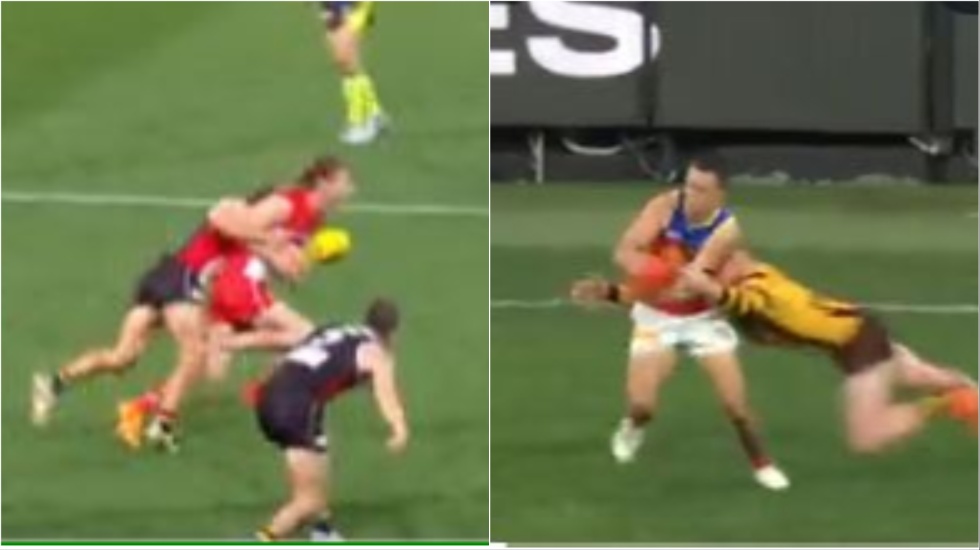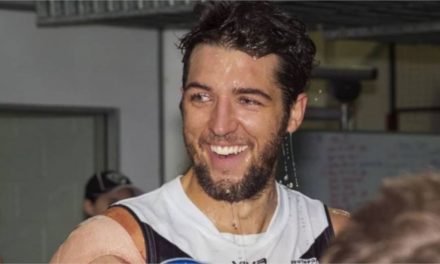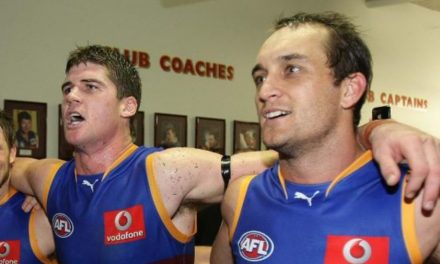Dan Butler tackles Nick Blakey (left); James Sicily launches a diving tackle on Hugh McCluggage. Pictures: FOX FOOTY
I’m always pretty sceptical about those dramatic claims that Australian football is dead or at the very least changed forever by this or that incident which has prompted a suspension and a storm of controversy.
We live in an age where sensationalism is par for the course and hyperbole a byword for modern media. But for one of the first times in my football-going life the other night, even I had similar thoughts.
The pretext was St Kilda’s Dan Butler’s tackle on Sydney’s Nick Blakey, and the Saint’s subsequent one-match penalty courtesy of the Match Review Officer. And they were misgivings which were only strengthened by looking at footage of Hawk James Sicily’s tackle on Brisbane’s Hugh McCluggage, an act which had him referred directly to the AFL Tribunal, where he will most likely receive a minimum three-game penalty.
But there could have been others. Every week without fail now there are a half-dozen incidents where Player A lays what has always been a textbook tackle designed not to hurt but merely dispossess an opponent and Player B, because of his or her body position, angle or what he’s doing with the ball, is unfortunately hurt.
We know what’s going on here, it’s the fight to minimise serious concussion-type injuries in the game. That’s a noble pursuit, not simply, as some would cynically suggest, only about protecting the game from disastrous legal actions.
But it’s always going to be a quest which is – pardon the inappropriate pun – butting heads with a game of which physical contact is a fundamental part. And while we’ve seen the consequences of that in the bump now being on the endangered species list, this latest development could be – literally – a whole new ball game.
Australian football would survive OK without the bump. It’s a choice a player makes, and a tackle instead, or even corralling a player, might have similar effectiveness in making life difficult for the player in possession of the football.
Surely, though, no one disputes it would be a different sport altogether without even tackling. And if acts like Butler’s and Sicily’s over the past few days are now deemed worthy of suspension, how can tackling be anything other than a lucky dip where the consequences are completely dependent upon how a tackled player emerges, something over which in many of these examples, the tackler has no control?
Butler could not have done anything more to avoid hurting Blakey on Thursday night after chasing down the Swan from behind. He turned Blakey to the side to minimize the physical impact, hence there was no body weight collapsing upon him. There was no secondary “driving” of Blakey’s body into the turf.
But Butler and Blakey were both running. Of course, any sort of contact between them was going to mean two bodies going to ground with at least some level of momentum. And unless we begin playing on mattresses, that will always mean some chance, however minimal, of injury.
PLEASE HELP US CONTINUE TO THRIVE BY BECOMING AN OFFICIAL FOOTYOLOGY PATRON. JUST CLICK THIS LINK.
Sicily’s tackle on McCluggage saw the Hawk skipper launching himself parallel to the ground simply to be able to reach the Brisbane midfielder in order to tackle him. Without feet grounded, Sicily had even less control than a tackling player usually does over how his opponent landed. But what was his alternative? Not to even try to tackle the Brisbane player?
Should Butler seriously consider prior to his chasing down of Blakey that running at pace and having to apply a reasonable amount of physical force to dispossess Blakey from behind means at least some chance of Blakey hitting the ground awkwardly and getting hurt, and thus, for Butler the chance of a suspension?
And how does that look aesthetically for the game, a player without the ball able to pursue and most likely catch a player in possession but choosing not to for fear of not just conceding a free kick, but perhaps missing the next couple of games through suspension?
Sadly, in the current environment, this is where we’re headed. Do coaches end up telling at least their half-dozen most important players never to tackle or bump, lest they inadvertently injure an opponent and end up being suspended?
That is not silly hyperbole, either. Really. Aren’t Marcus Bontempelli and the Western Bulldogs better served by effectively withdrawing altogether from a contest and perhaps conceding a goal than going full-bore to regain possession, stopping a goal but risking being rubbed out for the next game?
I’ve thought for many years now that the balance in the “consequences v intent” ledger had tipped way too far towards the former at the expense of the latter. But the impact of that imbalance is even more pronounced now given the increased focus and scrutiny of the effects of physical impact.
Even a few years ago, one could confidently conclude that if a player was about to receive a minimum three-game suspension, as Sicily is courtesy of the AFL Tribunal to which his matter has been referred, then his action must have been at best gratuitous, and at worst pretty nasty.
Now, however, it is quite feasible that a player may receive a minimum three-game suspension and perhaps even more for an act with no malice whatsoever attached to it, the intent merely to strip an opponent of the ball. All this while gratuitous, spiteful and potentially more damaging displays of machismo might attract fewer weeks on the sidelines.
That just doesn’t add up in my view. It sends the wrong message. It punishes the wrong things. And it effectively endangers one of the absolutely fundamental elements of our game. Does heightened sensitivity to player safety mean it’s worth the trouble? Well, call me a dinosaur, but I’m actually not sure in this case that it is.
This article first appeared at ESPN.












I am actually quite relieved that Hawthorn will not be involved in this season’s final series. I would have my heart in my mouth every single time a player laid a tackle, for fear their opponent would land awkwardly and affect our premiership chances. This is an absolutely ridiculous decision clearly based on the unfortunate outcome.
I’m glad Hawthorn have appealed it but have little confidence that the current tribunal system is capable of recognising its own shortcomings and the damage it is doing to our game. I feel sorry for the players who must have absolutely no clue how to avoid being the next one suspended after reasonably doing what both their coaches and fans expect.
maybe a solution to minimising head injury/concussion and the subsequent suspensions is to make helmets mandatory. how does our head injury/concussion instances measure up against the NFL?